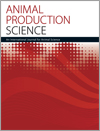
Animal Production Science
Volume 63 Number 14 2023
AN22355A review of some aspects of goat meat quality: future research recommendations
 , Robyn D. Warner
, Robyn D. Warner  , Frank R. Dunshea, Brian J. Leury, Minh Ha and Surinder S. Chauhan
, Frank R. Dunshea, Brian J. Leury, Minh Ha and Surinder S. Chauhan 
Goat meat is the most widely consumed red meat globally, but is also an underrated meat. Critical control points and factors affecting goat meat eating quality have yet to be fully elucidated. As a result, there is inconsistency in goat meat eating quality, which affects the growth and efficiency of the industry. Appropriate strategies such as consistency in slaughter age and weight, gender, muscles/cuts, electrical stimulation, slow and moist and sous-vide cooking techniques are recommended opportunities for the goat industry.
AN22355 Abstract | AN22355 Full Text | AN22355PDF (1.8 MB) Open Access Article
We used subcutaneous devices (bio-loggers), which are able to measure the body temperature, heart rate and locomotor activity of an animal, to study how intravaginal sponges used to synchronise the estrous cycle for artificial insemination of sheep affect physiological parameters. Moreover, the effect of ewes becoming pregnant was also studied. Our results evidenced that these devices provide a simple and non-invasive measurement of those variables, to provide the basis for a system that would identify those females that are in an optimal state for insemination and serve as an early pregnancy detection system.
AN22236Duration and sex-dependent effect of betaine supplementation on growth performance and carcass backfat of finisher pigs
 , Jake Walker, Chris J. Brewster, David J. Henman, Robert J. Smits, Jeremy J. Cottrell
, Jake Walker, Chris J. Brewster, David J. Henman, Robert J. Smits, Jeremy J. Cottrell  and Frank R. Dunshea
and Frank R. Dunshea
While developing strategies to reduce carcass fatness is vital to pig production efficiency, the variable responses of betaine supplementation in reducing carcass fatness prevented the adoption of this strategy in the pig industry. Our results demonstrated that the effectiveness of betaine in reducing carcass fatness is influenced by the supplementation duration and the sex of pigs. This finding improves the cost-effectiveness of betaine supplementation as a strategy to reduce carcass fatness and enhance the profitability of pig production.
AN23087Haemato-biochemical responses, worm burdens and Haemonchus contortus ultrastructural changes in lambs fed diets containing graded inclusion levels of sericea lespedeza

The challenges of feed scarcity and haemonchosis in sheep production may simultaneously be addressed by utilising nutraceutical forage legumes such as sericea lespedeza. Effects of substituting lucerne with increasing inclusion levels of sericea lespedeza up to 25% on haematological, biochemical, and parasitological parameters in Haemonchus contortus-infected lambs were, therefore, evaluated. Sericea lespedeza-based diets damaged adult H. contortus heads and had minor negative effects on haematological and biochemical parameters. Thus, sericea lespedeza may replace lucerne up to 25% in lamb feedlot diets.
AN22077Relationship between carcase traits of Bos taurus genotypes and ultrasound measurements across six stages of growth from weaning through to long-feedlot finishing
 , Amelia K. Almeida
, Amelia K. Almeida  , Malcolm McPhee
, Malcolm McPhee  , Jason P. Siddell, Brad Walmsley
, Jason P. Siddell, Brad Walmsley  , Paul L. Greenwood
, Paul L. Greenwood  and Matt L. Wolcott
and Matt L. Wolcott 
Earlier-life ultrasound measurements in beef cattle estimate later-life carcase characteristics. IMF ultrasound scans were strongly correlated with IMF of all measured muscles (Longissimus lumborum, bBiceps femoris, supraspinatus and infraspinatus muscles) except semitendinosus muscle. P8 rump fat can be reliably predicted with good accuracy earlier in life by using ultrasound.
AN22321Carcass traits and meat lipid profile of cull cows fed palm kernel cake
 , Dorgival M. Lima Júnior
, Dorgival M. Lima Júnior  and Robério R. Silva
and Robério R. Silva
Among the by-products derived from oilseeds, palm kernel cake (PKC) contains high concentrations of protein, fat, and fibre, which allows some flexibility in the use of this ingredient in ruminant diets. The PKC inclusion level of 10.3% provided the highest hot carcass weight (231 kg), whereas the total lipid content in the meat decreased linearly with PKC inclusion. We recommend the inclusion of 10% PKC in the diet of feedlot cull cows to improve their production performance, carcass traits, and meat fatty acid profile.
AN22437Multi-residue analysis of eight veterinary drugs in buffalo milk using liquid chromatography-tandem mass spectrometry†
 , Pingchuan Zhu, Qinqiang Sun, Runfeng Liu, Pengfei Zhang, Yuqi Liu, Wei Hu, Huiyan Xu, Yangqing Lu
, Pingchuan Zhu, Qinqiang Sun, Runfeng Liu, Pengfei Zhang, Yuqi Liu, Wei Hu, Huiyan Xu, Yangqing Lu  and Qiang Fu
and Qiang Fu 
Drug residues are more difficult to detect, and the analytical methods for drug residues in other milk sources cannot be effectively applied to buffalo milk. We developed an analytical method for veterinary drug residues in buffalo milk using liquid chromatography–tandem mass spectrometry. The findings of this study contribute to the risk assessment of veterinary drug residues for preventing the human consumption of contaminated buffalo milk and its derivatives.
AN23014Comparing the use of chloroform to petroleum ether for Soxhlet extraction of fat in meat
Chloroform is commonly used as a solvent for Soxhlet fat extraction for meat research in Australia, yet its validation has not been previously reported. A comparison has been made with the use of petroleum ether as an extraction solvent and chloroform has been found to be suitable for this purpose.
AN23014 Abstract | AN23014 Full Text | AN23014PDF (817 KB) Open Access Article
Crop residues have a good potential for use in ruminant diets as energy sources. The main limitations of using these residues as feedstuffs are the nutritional imbalances and the high rate of their natural lignin. In this research, the possibility of improving the nutritional value of common bean residues via chemical processing was investigated. In general, it was found that treatment with sodium hydroxide, hydrogen peroxide, and hydrobromic acid can improve the quality of these residues.



